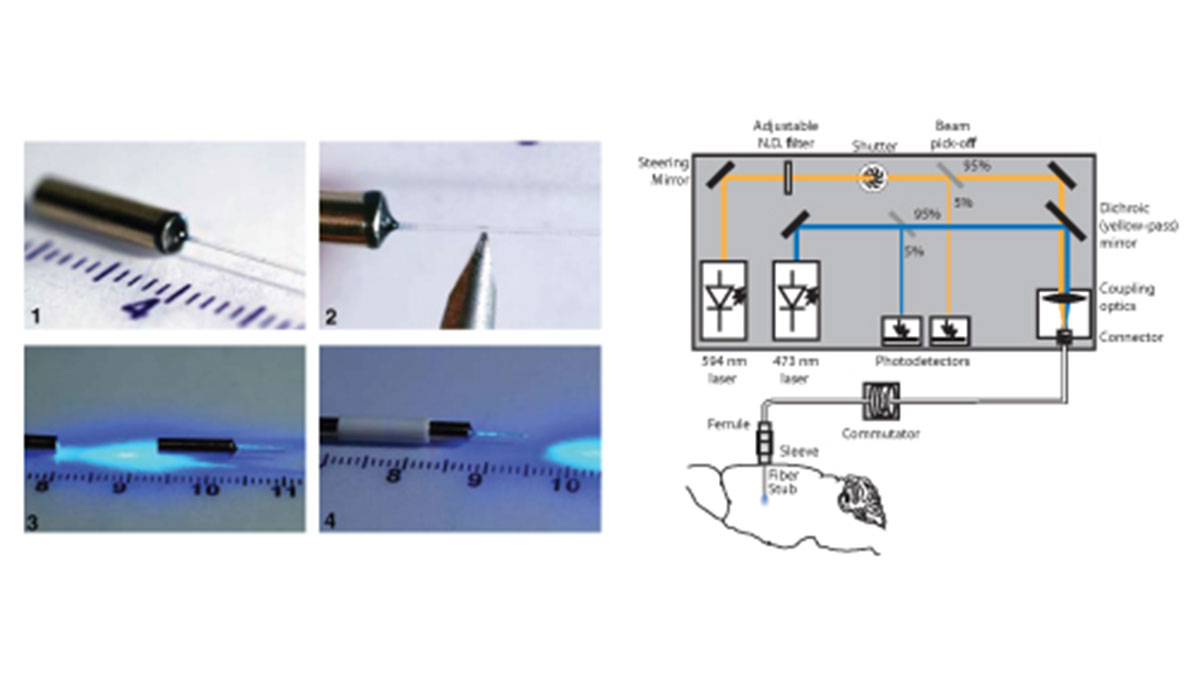Summary of Optogenetic hardware setup
Arthur English's group at Emory developed a compact, rechargeable, battery-powered laser diode driver for optical stimulation of peripheral nerves in anesthetized mice using a standard optical fiber. The device emits blue light (473 nm) to activate channelrhodopsin and can be controlled manually or via computer. It incorporates a laser LED coupled through a collimator to an FC/PC connector optical fiber patch cable. Comprehensive assembly instructions, PCB files, wiring details, and power output graphs support replication. Safety notes highlight the class 3B laser classification requiring precautions.
Parts used in the Laser Diode Driver Device:
- Laser diode (blue LED, 473 nm)
- Collimator lens
- Optical fiber patch cable with FC/PC connector (e.g., ThorLabs #M82L01)
- Laser diode driver circuit components (detailed in BOM)
- Rechargeable battery
- Enclosure (laser diode box)
- Control interface components (manual and analog input for computer control)
- Circuit board (custom PCB as per provided Eagle files)
- Connectors and wiring
Arthur English’s group at Emory has developed a custom device that they have used for stimulating peripheral nerves optically in anesthetized mice using a standard optical fiber. The device is compact, rechargeable battery-operated, and controlled either manually or by computer using analog input. Essentially, laser LED illumination is coupled to an optical fiber by a collimator and can be attached to a standard optical fiber patch cable with an FC/PC Connector (e.g.ThorLabs #M82L01). The device is considered a class 3B laser, so appropriate safety precautions must be taken. As described, the device outputs blue light suitable for activation of channelrhodopsin (473nM), but could be adapted to produce light of different wavelengths.
The zip file linked above includes
- Assembly
- Laser diode driver construction notes – detailed instructions for building the device
- Laser diode box wiring – instructions for internal wiring of the enclosure
- Laser diode driver V2A BOM – bill of materials (parts list)
- Eagle PCB files
- Board – top side – PDF view of top of board
- Schematic – PDF of electrical schematic
- Laser_diode_driver.sch – CadSoft Eagle schematic
- Laser_diode_driver.brd – CadSoft Eagle board layout
- Luminance graph
- Laser LED power output graph – A graph of the typical power output vs. voltage input
- Photos
- Complete set of phots to aid in construction
Optogenetics in Neural Systems: Neuron Primer
[ PDF ]

Yizhar O, Fenno LE, Davidson TJ, Mogri M, Deisseroth K.
Neuron. 2011 July;72:9-34.
Here we provide a primer on the application of optogenetics in neuroscience, focusing on the single-component tools and highlighting important problems, challenges, and technical considerations.
Optetrode: a multichannel readout for optogenetic control in freely moving mice.
[ PDF ]
Anikeeva P, Andalman AS, Witten I, Warden M, Goshen I, Grosenick L, Gunaydin LA, Frank LM, Deisseroth K.
Nature Neuroscience. 2011 Dec 4;15(1):163-70.
We designed and validated the optetrode, a device that allows for colocalized multi-tetrode electrophysiological recording and optical stimulation in freely moving mice. Optetrode manufacture employs a unique optical fiber-centric coaxial design approach that yields a lightweight (2 g), compact and robust device that is suitable for behaving mice. This low-cost device is easy to construct (2.5 h to build without specialized equipment). We found that the drive design produced stable high-quality recordings and continued to do so for at least 6 weeks following implantation.
Integrated device for combined optical neuromodulation and electrical recording for chronic in vivo applications.
[ PDF ]
Wang J, Wagner F, Borton DA, Zhang J, Ozden I, Burwell RD, Nurmikko AV, van Wagenen R, Diester I, Deisseroth K.
J Neural Eng. 2012 9:016001.
Read more: Optogenetic hardware setup
